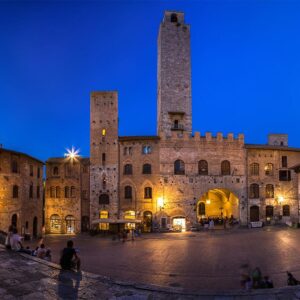San Gimignano
San Gimignano, a UNESCO World Heritage Site, has remained practically crystallised to the appearance it had in 1300, so as to represent one of the most interesting examples of urban organisation from the age of the Communes.
Situated on a hill that undoubtedly housed an Etruscan settlement, the first mention of the present-day town only dates back to the ninth century AD.
San Gimignano in history
At the time, the town was on one of the main routes of the Via Francigena, which Sigeric, Archbishop of Canterbury, travelled between 990 and 994. For him, this stage was the nineteenth on his return journey from Rome to England. The archbishop renamed the village with the name Sancte Gemiane, from which the present name of San Giminiano comes, and also marked the village as a point of intersection with the road between Pisa and Siena. Sancte Gemiane was the name of the holy bishop of Modena, famous for having defended the village from Attila’s occupation.
After a favourable historical period of economic growth, from 1300 onwards the village experienced a period of marked decline, helped by the plague that decimated the population.
 What to see in San Gimignano
What to see in San Gimignano
This decline, however, did not affect the artistic vein of the town, which saw, between the 14th and 15th centuries, numerous masters from the vicinity, especially from Siena and Florence, embellish all the ecclesiastical complexes with works by Memmo di Filippuccio, Lippo and Federico Memmi, Domenico Ghirlandaio, Piero del Pollaiolo and the native Sebastiano Mainardi.
This decline and the marginality of San Gimignano, in the following centuries, were the conditions that allowed the extraordinary crystallisation of its medieval appearance, the current pride of the village, which from the nineteenth century was rediscovered and enhanced beyond the Italian borders, becoming famous worldwide.
The Manhattan of the Middle Ages
San Gimignano is best known for the medieval towers that stand throughout the town. Of the 72 towers built over the centuries, only fourteen remain intact today. The oldest is undoubtedly the Rognosa tower, erected in the 13th century, while the tallest and most representative was the Torre del Podestà, also known as Torre Grossa, with its considerable height of 54 metres.
The entire village, however, gives the idea of having stopped in 1500, and wandering through its alleys and ravines is a harbinger of continuous surprises and a nostalgic feeling of a return to medieval times.
Villa dei Bosconi Surroundings
Florence
Fiesole
Siena
Lucca
Pisa
Chianti
Our Rooms
Standard Double
Superior Double
Triple
Quadruple

